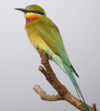INTRODUCTION
GETTING THERE
It was our intention to bird Sri Lanka this November, but due to the ineptitude of Emirates Airlines we were forced to cancel a trip we had spent many hours putting together. This was due to 5 altered flight times and 1 cancellation which changed the itinerary so much that we were continually altering the trip. With the trip looking less like the one we started with and with no guarantee that flight times would not continue to be altered, we bit the bullet and cancelled.
With no appetite to begin putting together another trip we decided to return to the Gambia, using the same format as our previous visits. With a large list of birds, hot sunny weather, great accommodation and a bird guide second to none, it was a no brainer.
Our first port of call was The Gambia Experience who put together the trip, including flights, accommodation and transfers. Our flight was from Birmingham, our local airport. We chose a 2 centre, 14 day trip. Our first week was to be at Ngala Lodge on the Atlantic coast in the main tourist area. Our second week was to be spent at Mandina Lodge which was tucked away amongst the mangroves on one of the River Gambia’s tributaries, both taken from the luxury accommodation section.
BIRD GUIDE
 The choice of bird guide was simple; we would engage the guide that in our opinion is the best in Gambia - Malick Suso. We have used Malick previously, he is extremely knowledgeable, very personable, reliable and punctual; all the attributes required. Malick has his own web site giving all his contact details, testimonies, and charges. Malick was engaged for the first week when we would be at Ngala Lodge, and it was our intention to do all of the local sites with him.
The choice of bird guide was simple; we would engage the guide that in our opinion is the best in Gambia - Malick Suso. We have used Malick previously, he is extremely knowledgeable, very personable, reliable and punctual; all the attributes required. Malick has his own web site giving all his contact details, testimonies, and charges. Malick was engaged for the first week when we would be at Ngala Lodge, and it was our intention to do all of the local sites with him.
Our second week was at Mandina Lodge where the package includes the services of our own personal guide to guide us through the myriad of tracks in the adjacent Makasutu Forest, a pirogue (dugout canoe) was also available for our personal use, accompanied again by our guide. With this in mind we paid Malick a retainer for the second week. Malick was unavailable on the 3rd and the 5th, so we employed Musa Manneh, a guide who came highly recommended by our friend and neighbour Brian Young who had visited the Gambia in 2015.
TRANSPORT
Transport is included in the guide’s charges; the normal practice is for the guide to employ a taxi and these can be of questionable quality. Most birding sites are within 25 minutes drive of the main tourist centres. If you wish to venture up-river it may be advisable to invest in something more comfortable and reliable.
FOOD
With so many Europeans visiting the Gambia the food is varied, with many dishes recognised as European cuisine. Local Dishes are also on offer and can be very tasty.
 LITERATURE
LITERATURE
Having a guide like Malick, a field guide of any description wasn’t really required, but to take a trip without one is like leaving your binoculars behind.
WEATHER
November is at the end of the rainy season so some rain can be expected. Daytime temperatures should be between the mid-70°F and the lower 80°F. With the breeding season just coming to an end many of the birds are still in their breeding finery, making the identification of some of the bishops and weavers etc a little easier, although a bird guide like Malick or Musa would have no difficulty.
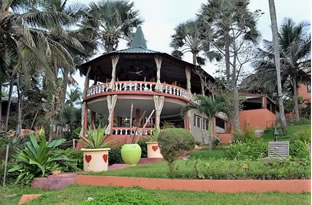 ACCOMMODATION
ACCOMMODATION
As previously stated we decided on a 2 centre holiday, the first week was to be spent on the coast where the main birding sites are situated and the second, tucked away in Mangroves on a small tributary of the River Gambia, this we hoped was to be a more relaxed affair. The first week was at the Ngala Lodge and the second was at the Mandina Lodge; you don’t have to suffer for your art, wonderful surroundings, hopefully great food and comfort can only enhance great birding.
DIARY
Day 1 - 1st November 2016
Brian, our friend and neighbour picked us up at 04.45 and had us at the airport by 05.15 where we were greeted by a large queue snaking its way for about 75 metres. We queued for 1hr 20mins before arriving at check-in. In response to our complaint we were told that Thomas Cook would only pay for 3 persons on the check-in, but we could have paid an extra £30 for a priority boarding pass. We arrived at Banjul bang on time and soon got through customs and picked up our cases from the carousel. We then went through the baggage x-ray machine where we were asked to step into a small room with 3 uniformed people waiting. One pointed to the letter “D” chalked on 1 of our cases. What is that supposed to mean we enquired! Drugs came the response in unison. To cut a long saga short, they were co-codamol which I take for a dodgy back. We arrived at our hotel in short order and proceeded to make ourselves comfortable. Hooded Vultures, Pied Crows, Plantain Eater, Speckled Pigeon, Mourning and Vinaceous Doves were all seen during the journey from the airport to the hotel. An early evening meal minus any alcohol saw us in bed for a little after nine; a fitful night’s sleep ensued for us both.
Day 2 - 2nd November
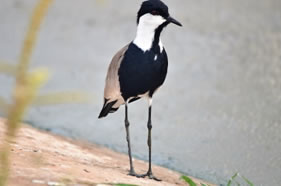 We met our bird guide Malick at 07.00 as arranged and made our way to Kotu sewage works via a small sandy path. The light was poor, almost misty; so no photographs. Blue-bellied Rollers sat on wires hawking insects from the patch of scrub below, Black Kites and Hooded Vultures drifted by; the first patch of scrub brought Senegal Coucal, Common Bulbul, Brown Babblers and Fork-tailed Drongos. A mature fruiting tree had both Fine-spotted and Grey Woodpeckers in it. As we reached the small lagoons that make up Kotu sewage works we could hear Spur-winged Lapwings and Black-winged Stilts enacting one of their ancient disputes for whatever reason! A slow walk around the lagoons produced 3 Squacco Herons, half a dozen Cattle Egrets, Common Sandpipers, Green Sandpipers, a single Redshank and a solitary Wood Sandpiper. A pair of Little Grebe kept to the centre of the lagoons, the only ones for the trip. Leaving the sewage ponds we made our way through the rice fields where Little Bee-eaters hawked in the slow-to-clear gloom. Malick spotted a Shikra in flight mobbing a roosting Lizard Buzzard. With no other new birds seen we continued the short walk to Kotu Creek. The power lines held Red-chested, Wire-tailed and Barn Swallows. A Long-tailed Cormorant surfaced and quickly dived again just a few metres from the bridge and a Darter circled looking for somewhere to land. A
We met our bird guide Malick at 07.00 as arranged and made our way to Kotu sewage works via a small sandy path. The light was poor, almost misty; so no photographs. Blue-bellied Rollers sat on wires hawking insects from the patch of scrub below, Black Kites and Hooded Vultures drifted by; the first patch of scrub brought Senegal Coucal, Common Bulbul, Brown Babblers and Fork-tailed Drongos. A mature fruiting tree had both Fine-spotted and Grey Woodpeckers in it. As we reached the small lagoons that make up Kotu sewage works we could hear Spur-winged Lapwings and Black-winged Stilts enacting one of their ancient disputes for whatever reason! A slow walk around the lagoons produced 3 Squacco Herons, half a dozen Cattle Egrets, Common Sandpipers, Green Sandpipers, a single Redshank and a solitary Wood Sandpiper. A pair of Little Grebe kept to the centre of the lagoons, the only ones for the trip. Leaving the sewage ponds we made our way through the rice fields where Little Bee-eaters hawked in the slow-to-clear gloom. Malick spotted a Shikra in flight mobbing a roosting Lizard Buzzard. With no other new birds seen we continued the short walk to Kotu Creek. The power lines held Red-chested, Wire-tailed and Barn Swallows. A Long-tailed Cormorant surfaced and quickly dived again just a few metres from the bridge and a Darter circled looking for somewhere to land. A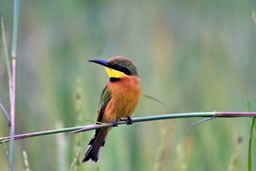 pair of Pied Kingfishers was located as was a Blue-breasted Kingfisher, half hidden in the tall reeds that fringe the creek. With the gloom now burned off and the temperature beginning to rise we found some shade and had breakfast, which consisted of hard boiled eggs and buttered home-made bread. A short walk along the cycle path produced African Silverbills, Red-cheeked Cordon-Bleus and a solitary Hamerkop. A familiar sound brought our attention to a flitting Zitting Cisticola; a small flock of Green Wood Hoopoes gave tantalising glimpses as they chased each other around the major branches of a nearby tree. At 12.30 with temperatures reaching the mid 30°C we called it a day and returned to the hotel.
pair of Pied Kingfishers was located as was a Blue-breasted Kingfisher, half hidden in the tall reeds that fringe the creek. With the gloom now burned off and the temperature beginning to rise we found some shade and had breakfast, which consisted of hard boiled eggs and buttered home-made bread. A short walk along the cycle path produced African Silverbills, Red-cheeked Cordon-Bleus and a solitary Hamerkop. A familiar sound brought our attention to a flitting Zitting Cisticola; a small flock of Green Wood Hoopoes gave tantalising glimpses as they chased each other around the major branches of a nearby tree. At 12.30 with temperatures reaching the mid 30°C we called it a day and returned to the hotel.
Total number of species seen today 61
Day 3 - 3rd November
Today was our first day with Musa; he, like Malick, was exemplary in his punctuality and was waiting at the front of the hotel when we emerged. Today we were to visit the Mandinaba Forest, a favourite of Musa’s. We stopped en-route for a very obliging Lizard Buzzard on the wires at the side of the road. 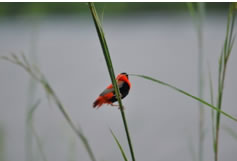 A Northern Bishop in his breeding finery also put in an appearance, necessitating a dash from one side of a very busy road to the other. We arrived at Mandinaba a little after 07.30 and proceeded down a small sandy track, busy with people going about their business; the birds followed thick and fast: Yellow-billed Shrike, Mourning Doves, Green Pigeons, Plantain Eater, Beautiful Sunbird, Grey Woodpecker several fly-bys of Black Kites, a pair of Hooded Vultures were encountered emerging from their slumbers and an African Hawk Eagle landed on a nearby tree and began prospecting all likely cavities - he obviously had breakfast on his mind. It’s not my intention to name every bird encountered daily, but to select some to help paint a picture of that day’s birding. A full list of birds will accompany this report. Several small parties of Senegal Parrots passed noisily overhead. Red Colobus Monkeys were lazing in a large open-canopied tree and a Sun Squirrel sat on the chopped fronds of a nearby Palm tree. We entered some communal village gardens where women were drawing water from the wells and individually watering each precious plant. Spur-winged and Wattled Plovers were in attendance, along with a couple of Squacco Herons and an Intermediate Egret hunted between the rows of crops. Musa found 2 Tawny Eagles roosting in a large tree adjacent to the path. Our direction of travel meant that we passed beneath the tree, disturbing the Eagles which flew to a nearby tree noisily scolding us as they landed; this in turn alerted a hitherto unseen Black-Shouldered Kite which began mobbing the hapless eagles. We had breakfast at this point in the shade of a small fig tree prior to retracing our steps back to the car. Our final stop of the morning was at Pirang Forest where we were lucky to see 3 “lifers”. We parked at the small warden’s hut where a water trough had been erected for the forest birds together with a bench on which to sit and observe. The trough was in deep shade so no photography; we were happy just to sit and watch Cordon Bleu, Firefinch and a male Paradise Flycatcher drink and bathe. It became a little surreal when a Pigmy Kingfisher turned up just to watch the antics of the other birds. Accompanied by the warden we ventured into the forest where we encountered our “lifers”; firstly a Green Hylia, not uncommon but very skulking, preferring dense cover.
A Northern Bishop in his breeding finery also put in an appearance, necessitating a dash from one side of a very busy road to the other. We arrived at Mandinaba a little after 07.30 and proceeded down a small sandy track, busy with people going about their business; the birds followed thick and fast: Yellow-billed Shrike, Mourning Doves, Green Pigeons, Plantain Eater, Beautiful Sunbird, Grey Woodpecker several fly-bys of Black Kites, a pair of Hooded Vultures were encountered emerging from their slumbers and an African Hawk Eagle landed on a nearby tree and began prospecting all likely cavities - he obviously had breakfast on his mind. It’s not my intention to name every bird encountered daily, but to select some to help paint a picture of that day’s birding. A full list of birds will accompany this report. Several small parties of Senegal Parrots passed noisily overhead. Red Colobus Monkeys were lazing in a large open-canopied tree and a Sun Squirrel sat on the chopped fronds of a nearby Palm tree. We entered some communal village gardens where women were drawing water from the wells and individually watering each precious plant. Spur-winged and Wattled Plovers were in attendance, along with a couple of Squacco Herons and an Intermediate Egret hunted between the rows of crops. Musa found 2 Tawny Eagles roosting in a large tree adjacent to the path. Our direction of travel meant that we passed beneath the tree, disturbing the Eagles which flew to a nearby tree noisily scolding us as they landed; this in turn alerted a hitherto unseen Black-Shouldered Kite which began mobbing the hapless eagles. We had breakfast at this point in the shade of a small fig tree prior to retracing our steps back to the car. Our final stop of the morning was at Pirang Forest where we were lucky to see 3 “lifers”. We parked at the small warden’s hut where a water trough had been erected for the forest birds together with a bench on which to sit and observe. The trough was in deep shade so no photography; we were happy just to sit and watch Cordon Bleu, Firefinch and a male Paradise Flycatcher drink and bathe. It became a little surreal when a Pigmy Kingfisher turned up just to watch the antics of the other birds. Accompanied by the warden we ventured into the forest where we encountered our “lifers”; firstly a Green Hylia, not uncommon but very skulking, preferring dense cover. 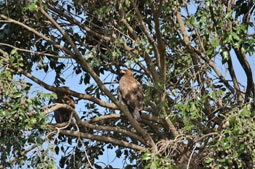 Our second encounter was the Yellowbill, a bird of the high canopy and described as rare to uncommon. Our third encounter was with a beautiful male White-spotted Flufftail, this bird was eventually coaxed into view by both guide and warden expertly mimicking its call. What a superb bird; even in its dimly lit forest undergrowth home, the colours shone brightly. We returned to the vehicle for our journey back to the hotel. Halfway up the long access track a noise suggested problems with the vehicle; an inspection indicated a front wheel puncture. We left the vehicle and sought some shade under a nearby tree, leaving both driver and guide to replace the tyre. It would be true to say that they would struggle to get a job in a Formula One pit crew; however punctured tyre eventually replaced, we continued on our return.
Our second encounter was the Yellowbill, a bird of the high canopy and described as rare to uncommon. Our third encounter was with a beautiful male White-spotted Flufftail, this bird was eventually coaxed into view by both guide and warden expertly mimicking its call. What a superb bird; even in its dimly lit forest undergrowth home, the colours shone brightly. We returned to the vehicle for our journey back to the hotel. Halfway up the long access track a noise suggested problems with the vehicle; an inspection indicated a front wheel puncture. We left the vehicle and sought some shade under a nearby tree, leaving both driver and guide to replace the tyre. It would be true to say that they would struggle to get a job in a Formula One pit crew; however punctured tyre eventually replaced, we continued on our return.
Day 4 - 4th November
Today dawned overcast, but still very warm with humidity remaining high. Malick was waiting, car doors open, anticipating our arrival. It was decided that we would visit Abuko rice fields and Nature Reserve. The journey took about half an hour; the on-road traffic appears to have more than doubled since our last visit 8 years ago. 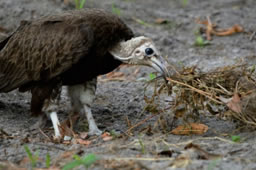 The beaten up old lorries still ply the same routes belching out noxious fumes, dozens are encountered broken down by the side of the road. The yellow and green taxis are still pulling out or stopping to pick up fares without any indication as they always have done. The constant blowing of horns is reminiscent of being in one of the major cities in India. Our first port of call was Abuko rice fields which was entered through a Palm Plantation. Hooded Vultures were on the ground tugging at matted palm fronds to use for nesting material. Malick spotted 2 Shikra in one of the palms and he was convinced that they were nesting nearby. As we entered the rice fields proper, several Squacco Herons stood sentinel-like on the banks of the paddies; Great Egrets were already at work slowly working the paddies, head tilted to one side to aid the detection of their prey. 3 Goliath Herons passed overhead in close formation followed by a Purple Heron and then another single Goliath.
The beaten up old lorries still ply the same routes belching out noxious fumes, dozens are encountered broken down by the side of the road. The yellow and green taxis are still pulling out or stopping to pick up fares without any indication as they always have done. The constant blowing of horns is reminiscent of being in one of the major cities in India. Our first port of call was Abuko rice fields which was entered through a Palm Plantation. Hooded Vultures were on the ground tugging at matted palm fronds to use for nesting material. Malick spotted 2 Shikra in one of the palms and he was convinced that they were nesting nearby. As we entered the rice fields proper, several Squacco Herons stood sentinel-like on the banks of the paddies; Great Egrets were already at work slowly working the paddies, head tilted to one side to aid the detection of their prey. 3 Goliath Herons passed overhead in close formation followed by a Purple Heron and then another single Goliath.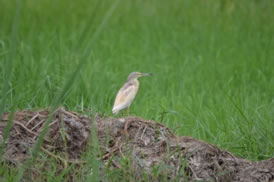 Grey Herons appeared out of the gloom, their plumage not making them as conspicuous as the White Egrets. Other birds seen were several Striated Herons, African Jacanas, African Rails and Long-tailed Cormorants. Both Northern Red and Yellow Bishops shone brightly in the fast retreating gloom. Having spent several hours in the rice fields and breakfast calling, we made our way to the Abuko Nature Reserve. We breakfasted in the large hide overlooking the pool. A Palm Nut Vulture was found nesting in the crown of one of the palms. An African Thrush, another new bird for us, was seen and photographed in the bushes adjacent to the hide. A Broad-billed Roller hawked from a tree in front of the hide; a Violet Turaco was briefly seen whilst a Giant Kingfisher incessantly called from the rear of the hide. A walk through the reserve produced very little, probably due to Red Colobus Monkeys crashing through the canopy. A fume-choking, horn-blowing drive had us back at the hotel a little after 1pm.
Grey Herons appeared out of the gloom, their plumage not making them as conspicuous as the White Egrets. Other birds seen were several Striated Herons, African Jacanas, African Rails and Long-tailed Cormorants. Both Northern Red and Yellow Bishops shone brightly in the fast retreating gloom. Having spent several hours in the rice fields and breakfast calling, we made our way to the Abuko Nature Reserve. We breakfasted in the large hide overlooking the pool. A Palm Nut Vulture was found nesting in the crown of one of the palms. An African Thrush, another new bird for us, was seen and photographed in the bushes adjacent to the hide. A Broad-billed Roller hawked from a tree in front of the hide; a Violet Turaco was briefly seen whilst a Giant Kingfisher incessantly called from the rear of the hide. A walk through the reserve produced very little, probably due to Red Colobus Monkeys crashing through the canopy. A fume-choking, horn-blowing drive had us back at the hotel a little after 1pm.
Day 5 - 5th November
Today we were back with Musa: light rain was falling as we left the hotel and the leaden skies were a little worrying. The rain didn’t appear to get any worse so as we reached our chosen site, Pirang Shrimp Farm, we decided that we would press on without rainwear. In fact, apart from the occasional odd spot of rain we were not troubled.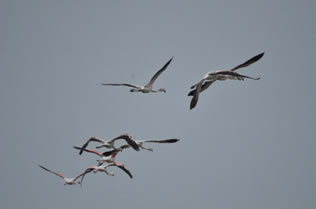 Musa decided to alight from the vehicle a few hundred yards from the entrance. This area was agricultural land, possibly rice and the lush grassy vegetation with the occasional tree soon offered up some avian treats. A Grey Kestrel was seen in a nearby tree, then an Abyssinian Roller, Fly-by Palm Nut Vultures, Great Egrets, Western Reef Heron, Hamerkop, Darter, Long-tailed Cormorants and several sizable flocks of White-faced Whistling Ducks indicated that the terrain was definitely aquatic. Once inside the defunct farm, semi-dry shrimp pans stretched out into the distance, each containing various amounts of water. Slowly walking around the pans produced many birds of which these are a few: Lesser and Greater Flamingo, Striated Heron, Pink-backed and Great White Pelican, Ringed Plover, Black and Bar-tailed Godwit, Avocet, Curlew Sandpiper, Dunlin, Little Stint, Green Sandpiper, Senegal Thick-knee, Sanderling, Common and Spotted Redshank, Caspian and Sandwich Terns were all found. We slowly birded the farm until just after noon when temperatures were beginning to get a little uncomfortable and we returned to our hotel.
Musa decided to alight from the vehicle a few hundred yards from the entrance. This area was agricultural land, possibly rice and the lush grassy vegetation with the occasional tree soon offered up some avian treats. A Grey Kestrel was seen in a nearby tree, then an Abyssinian Roller, Fly-by Palm Nut Vultures, Great Egrets, Western Reef Heron, Hamerkop, Darter, Long-tailed Cormorants and several sizable flocks of White-faced Whistling Ducks indicated that the terrain was definitely aquatic. Once inside the defunct farm, semi-dry shrimp pans stretched out into the distance, each containing various amounts of water. Slowly walking around the pans produced many birds of which these are a few: Lesser and Greater Flamingo, Striated Heron, Pink-backed and Great White Pelican, Ringed Plover, Black and Bar-tailed Godwit, Avocet, Curlew Sandpiper, Dunlin, Little Stint, Green Sandpiper, Senegal Thick-knee, Sanderling, Common and Spotted Redshank, Caspian and Sandwich Terns were all found. We slowly birded the farm until just after noon when temperatures were beginning to get a little uncomfortable and we returned to our hotel.
Day 6 - 6th November
Today was to be an owl day: we were off to Brufut Woods and a meeting with Dr Owl, a local man who has carved out a niche for himself by locating and showing several species of owl and roosting nightjars to visiting birders. As per usual Malick was waiting for us at 07.00: the dawn seemed brighter with a strong wind rustling the fronds on the large Palms outside our room. Temperatures were a little more comfortable than previously encountered. After a 30 minute drive we arrived at the bustling village of Brufut, the shops were beginning to open and people were already going about their business. “Twobarb” was directed at us by several groups of children; a relic from colonial times. We parked outside a large pair of metal gates which Malick informed us was the entrance to the “ladies' gardens” and the home of our first quarry - Verreaux’s Eagle Owl. 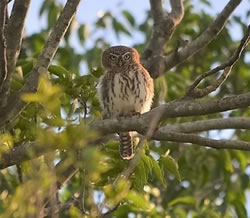 Entering through the gates we soon found Long-tailed Starlings, Brown Babblers, Red-billed Firefinches, Grey and Red-billed Hornbills. We approached a massive Silk Cotton Tree and Dr Owl, using a laser pen, pinpointed the location of the owl. Retracing our steps we exited the gardens through the gates and headed into the wood via a sandy track which was bordered by a huge mound a rubbish stretching for at least 50 metres. We were informed that this was the villagers’ rubbish, illegally dumped. A hapless chap was spotted discarding a large bag of rubbish on the pile and endured a chastising by both Malick and Dr Owl. We found Woodland Kingfisher, Senegal Coucal, Singing Cisticola, Village Weavers and Bronze-tailed Glossy Starling. A Melodious Warbler was a pleasant surprise. At this point we deviated from the path and headed into what looked to be a plantation of young trees. A large bush adjacent to a stone wall produced our second owl, Northern White-faced Owl. The trusty laser pen was employed again, although this owl was far more difficult to see; just visible through some thick foliage. We re-joined the track, finding our transport parked in the shade and the driver fast asleep. Malick explained we would take breakfast at a WABSA bush camp, a 5 minute drive away. The only indication of the camp was a WABSA sign half hidden by vegetation.
Entering through the gates we soon found Long-tailed Starlings, Brown Babblers, Red-billed Firefinches, Grey and Red-billed Hornbills. We approached a massive Silk Cotton Tree and Dr Owl, using a laser pen, pinpointed the location of the owl. Retracing our steps we exited the gardens through the gates and headed into the wood via a sandy track which was bordered by a huge mound a rubbish stretching for at least 50 metres. We were informed that this was the villagers’ rubbish, illegally dumped. A hapless chap was spotted discarding a large bag of rubbish on the pile and endured a chastising by both Malick and Dr Owl. We found Woodland Kingfisher, Senegal Coucal, Singing Cisticola, Village Weavers and Bronze-tailed Glossy Starling. A Melodious Warbler was a pleasant surprise. At this point we deviated from the path and headed into what looked to be a plantation of young trees. A large bush adjacent to a stone wall produced our second owl, Northern White-faced Owl. The trusty laser pen was employed again, although this owl was far more difficult to see; just visible through some thick foliage. We re-joined the track, finding our transport parked in the shade and the driver fast asleep. Malick explained we would take breakfast at a WABSA bush camp, a 5 minute drive away. The only indication of the camp was a WABSA sign half hidden by vegetation. 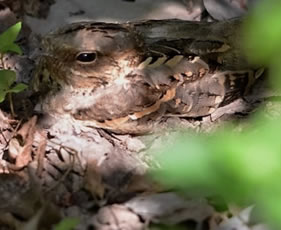 The camp consisted of several rows of rustic benches, a bar, constructed of rough sawn timber, from which fresh made coffee was on offer, as were cold drinks dispensed from a cool-box. Several containers were filled with water under the instruction of Dr Owl. We spent the next half hour breakfasting and watching Greater Honeyguide, Black-billed Wood Dove, Pygmy Kingfisher, Lavender Waxbills, Village Weaver, Firefinches etc drinking and bathing. A short walk after breakfast brought our third owl of the morning, a Pearl-spotted Owlet and a roosting Long-tailed Nightjar. We returned back to camp and spent another pleasant half an hour watching the birds and talking to a couple of Danish birders who had arrived during our absence. With the time a little after 12.00 noon and the temperatures in the 30°C we returned to the air-conditioned comfort of our hotel.
The camp consisted of several rows of rustic benches, a bar, constructed of rough sawn timber, from which fresh made coffee was on offer, as were cold drinks dispensed from a cool-box. Several containers were filled with water under the instruction of Dr Owl. We spent the next half hour breakfasting and watching Greater Honeyguide, Black-billed Wood Dove, Pygmy Kingfisher, Lavender Waxbills, Village Weaver, Firefinches etc drinking and bathing. A short walk after breakfast brought our third owl of the morning, a Pearl-spotted Owlet and a roosting Long-tailed Nightjar. We returned back to camp and spent another pleasant half an hour watching the birds and talking to a couple of Danish birders who had arrived during our absence. With the time a little after 12.00 noon and the temperatures in the 30°C we returned to the air-conditioned comfort of our hotel.
Day 7 - 7th November
Today was a momentous occasion: we were going to have a cooked breakfast instead of the horrendous fare we have been issued with by the hotel masquerading as a packed breakfast. We left at 07.00 as usual for the short drive to Tanji Reserve; the reason for this trip was to try to get some decent photos of terns and gulls. We left the vehicle at a sandy track leading to an area of rank grasses with scattered bushes. 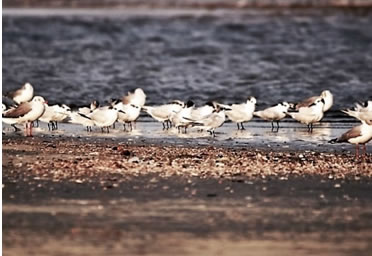 Our first bird was a Lizard Buzzard sitting on the wires above the track. Fly-bys of Hooded Vultures, Red-billed Hornbills and several Ospreys caught our attention almost immediately. A Variable Sunbird, Yellow-fronted Tinkerbird, Grey Hornbill, Beautiful Sunbird, Grey Woodpecker, Vieillot’s and Bearded Barbets, African Yellow Oriole and Little Bee-eaters were some of the birds seen in the 200 metres before we hit the beach. Several Four-banded Sandgrouse were flushed as was a female Standard-tailed Nightjar. Hundreds of shore birds were roosting along the strand line. Ospreys were plunge diving for fish whilst several Grey Herons patrolled the shallows just behind the breaking waves. As previously stated it had been our intention to photograph many of the shore species present but we were unable to get close enough. We returned to the hotel for the eagerly anticipated breakfast. Sated, we re-joined Malick for a meeting with a man who was prepared to rent us some fishing tackle in readiness for our stay at Mandina Lodge. Business completed, a trip to Camaloo Corner produced Bar-tailed Godwits, Greenshank, Redshank, Little Stint, Grey Plover, Spur-winged, Wattled and Black-headed Plovers and Senegal Thick-knee. Little Swifts were hawking for insects and then diving under the road bridge to feed their broods. We returned back to the hotel just after noon.
Our first bird was a Lizard Buzzard sitting on the wires above the track. Fly-bys of Hooded Vultures, Red-billed Hornbills and several Ospreys caught our attention almost immediately. A Variable Sunbird, Yellow-fronted Tinkerbird, Grey Hornbill, Beautiful Sunbird, Grey Woodpecker, Vieillot’s and Bearded Barbets, African Yellow Oriole and Little Bee-eaters were some of the birds seen in the 200 metres before we hit the beach. Several Four-banded Sandgrouse were flushed as was a female Standard-tailed Nightjar. Hundreds of shore birds were roosting along the strand line. Ospreys were plunge diving for fish whilst several Grey Herons patrolled the shallows just behind the breaking waves. As previously stated it had been our intention to photograph many of the shore species present but we were unable to get close enough. We returned to the hotel for the eagerly anticipated breakfast. Sated, we re-joined Malick for a meeting with a man who was prepared to rent us some fishing tackle in readiness for our stay at Mandina Lodge. Business completed, a trip to Camaloo Corner produced Bar-tailed Godwits, Greenshank, Redshank, Little Stint, Grey Plover, Spur-winged, Wattled and Black-headed Plovers and Senegal Thick-knee. Little Swifts were hawking for insects and then diving under the road bridge to feed their broods. We returned back to the hotel just after noon.
Day 8 - 8th November
Today was a moving day, so very little birding was done apart from in the late afternoon at Mandina. A beat-up 12 seater bus arrived punctually at 11.45 and we were soon on our way. 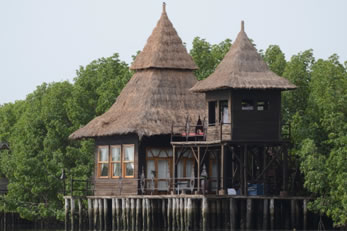 The driver stopped for a 10 minute chat at a Bureau de Change before continuing on to a hotel complex we know-not-where. We were stopped from entering the aforementioned complex so the driver parked up and jumped out saying he would go and fetch the other two clients he was also transferring to Mandina; news to us!! A motorcade exited the complex with apparently the vice-president aboard. Our driver returned empty handed saying we could now enter the complex. We parked outside a hotel entrance and again the driver disappeared. To cut a very long and tedious story to a conclusion, we were at the wrong hotel; we eventually picked up the guests at another hotel and made our way to Mandina. The 45 minute journey took nearer two hours and all in a jalopy with no air-conditioning: thanks Gambia Experience and this is their premier service! We arrived at Mandina and were greatly impressed at the set-up and the genuine warmth of our greeting. Mandina is set along a mangrove backwater of the Gambia River, almost as far from the hustle and bustle that is Gambia today as you can get. Our accommodation was the “stilted lodge” built on timber piles driven into the river bed. A small spot of birding took place before our evening meal, which was very good and a very hot night with little sleep ensued.
The driver stopped for a 10 minute chat at a Bureau de Change before continuing on to a hotel complex we know-not-where. We were stopped from entering the aforementioned complex so the driver parked up and jumped out saying he would go and fetch the other two clients he was also transferring to Mandina; news to us!! A motorcade exited the complex with apparently the vice-president aboard. Our driver returned empty handed saying we could now enter the complex. We parked outside a hotel entrance and again the driver disappeared. To cut a very long and tedious story to a conclusion, we were at the wrong hotel; we eventually picked up the guests at another hotel and made our way to Mandina. The 45 minute journey took nearer two hours and all in a jalopy with no air-conditioning: thanks Gambia Experience and this is their premier service! We arrived at Mandina and were greatly impressed at the set-up and the genuine warmth of our greeting. Mandina is set along a mangrove backwater of the Gambia River, almost as far from the hustle and bustle that is Gambia today as you can get. Our accommodation was the “stilted lodge” built on timber piles driven into the river bed. A small spot of birding took place before our evening meal, which was very good and a very hot night with little sleep ensued.
Day 9 - 9th November
We met our personal guide Lamin at the pre-arranged time 07.00 for a pre-breakfast canoe ride through the mangroves. A Goliath Heron was the first bird seen; it was loafing on one of the floating lodges; a Common Sandpiper skimmed the surface in front of the boat. Senegal Parrots, Pied and Blue-breasted Kingfishers, Senegal Thick-knee, Whimbrel, Plantain Eater, White-throated Bee-eaters and African Pied Hornbills were all seen in the mangroves that lined this particular backwater. 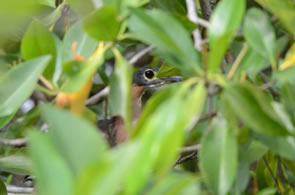 We slowly approached a low hanging mangrove branch where we were shown a White-backed Night Heron’s nest containing 3 chicks. The parent bird was standing sentinel-like in some dense foliage adjacent to the nest. We alighted the canoe after about an hour and walked around some wet meadows and a quarry where small-scale quarrying for building materials was taking place. The walk took about half an hour and some of the birds encountered were Yellow-billed Kite, Broad-billed Roller, Pigmy Kingfisher, Double-spurred Francolin, Common Bulbul, Long-tailed Glossy Starling, Rose-ringed Parakeets, Green Wood Hoopoes, Piapiac, Striated Heron, Splendid Sunbird, several Wattled Plovers together with Cattle Egrets fed among the rank vegetation. We returned to base camp where a “full English” was enjoyed. By mid-morning the temperatures were nudging into the high 30°C, humidity must have been almost 100% and with temperatures forecast to go even higher, we reluctantly decided that our stay was going to be cut short. Nestling in the mangroves meant no cooling breeze and night-time temperatures were maintained by the dark stained timber used in the construction of our lodge. The decking got so hot that to walk bare footed meant risking blistered feet. We contacted The Gambia Experience who facilitated our transfer from this wonderful idyll to a hotel back on the coast. The Coco Ocean was to be our home for the remainder of the holiday. A cooling sea breeze, low humidity and air conditioning would ease our concerns. The Gambia Experience were excellent and we can’t praise them enough for their prompt action. We arrived at Coco Ocean at just gone 19.30; just enough time to have our fourth shower of the day, have an evening meal and some much needed sleep.
We slowly approached a low hanging mangrove branch where we were shown a White-backed Night Heron’s nest containing 3 chicks. The parent bird was standing sentinel-like in some dense foliage adjacent to the nest. We alighted the canoe after about an hour and walked around some wet meadows and a quarry where small-scale quarrying for building materials was taking place. The walk took about half an hour and some of the birds encountered were Yellow-billed Kite, Broad-billed Roller, Pigmy Kingfisher, Double-spurred Francolin, Common Bulbul, Long-tailed Glossy Starling, Rose-ringed Parakeets, Green Wood Hoopoes, Piapiac, Striated Heron, Splendid Sunbird, several Wattled Plovers together with Cattle Egrets fed among the rank vegetation. We returned to base camp where a “full English” was enjoyed. By mid-morning the temperatures were nudging into the high 30°C, humidity must have been almost 100% and with temperatures forecast to go even higher, we reluctantly decided that our stay was going to be cut short. Nestling in the mangroves meant no cooling breeze and night-time temperatures were maintained by the dark stained timber used in the construction of our lodge. The decking got so hot that to walk bare footed meant risking blistered feet. We contacted The Gambia Experience who facilitated our transfer from this wonderful idyll to a hotel back on the coast. The Coco Ocean was to be our home for the remainder of the holiday. A cooling sea breeze, low humidity and air conditioning would ease our concerns. The Gambia Experience were excellent and we can’t praise them enough for their prompt action. We arrived at Coco Ocean at just gone 19.30; just enough time to have our fourth shower of the day, have an evening meal and some much needed sleep.
Day 10 - 10th November
Having re-arranged our meeting with Malick, he arrived at the hotel to reschedule the rest of the trip. We decided to have a couple of hours at Tujering and leave Kartong for the following day. 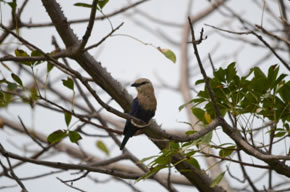 We were at Tujering by 11.00 and just did the track leading down to the old settlement: as we had started much later the heat was a factor from the start, necessitating several stops under shady trees. As on a couple of times this trip, one of the first birds seen was a Shikra, closely followed by a Senegal Batis. Here Cisticolas came in quick succession; firstly Whistling, then Zitting and ending up with Singing. A Blue-bellied Roller frog-hopped from tree to tree in front of us and both Variable and Beautiful Sunbirds were encountered. A distant Black-shouldered Kite was scoped and a fly-by by a juvenile Palm Nut Vulture was enjoyed. A Black-crowned Tchagra gave good views from the top of a nearby bush, closely followed by a beautiful male Klaas’s Cuckoo, its metallic green plumage glinting in the sun. Another stunning bird, the Chestnut-crowned Sparrow Weaver was also observed. The first Yellow-fronted Canary of the trip concluded our walk.
We were at Tujering by 11.00 and just did the track leading down to the old settlement: as we had started much later the heat was a factor from the start, necessitating several stops under shady trees. As on a couple of times this trip, one of the first birds seen was a Shikra, closely followed by a Senegal Batis. Here Cisticolas came in quick succession; firstly Whistling, then Zitting and ending up with Singing. A Blue-bellied Roller frog-hopped from tree to tree in front of us and both Variable and Beautiful Sunbirds were encountered. A distant Black-shouldered Kite was scoped and a fly-by by a juvenile Palm Nut Vulture was enjoyed. A Black-crowned Tchagra gave good views from the top of a nearby bush, closely followed by a beautiful male Klaas’s Cuckoo, its metallic green plumage glinting in the sun. Another stunning bird, the Chestnut-crowned Sparrow Weaver was also observed. The first Yellow-fronted Canary of the trip concluded our walk.
Day 11 - 11th November
We were on the road for 06.30 today for the 45 minute drive to Kartong, a new site for us and a spot Dave Gosney reckons to be the best in the Gambia. We stopped at a large water filled quarry which Malick said was freshwater and a magnet to birds like kingfishers and bee-eaters. 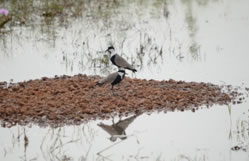 He was absolutely correct about the Kingfishers with, Giant, Brown-headed, Malachite, and Pied all seen. Malick expertly called in a male Sulphur-breasted Bush Shrike, one of his personal favourites, quickly followed by a Western Violet-backed Sunbird. Several Ospreys were seen all carrying fish and flights of Pink-backed Pelicans passed overhead. We walked down to the water’s edge flushing a Green Sandpiper which flew off calling defiantly. Two Common Sandpipers chased each other, sending two hidden Senegal Thick-knees to flight. Three White-breasted Cormorants looked to land but thought better of it and moved on. Northern Black Flycatcher and Snowy-crowned Robin Chats, both new for the trip, were seen well. A great half hour and hopefully a prelude of what was to come. Kartong proper is a series of shallow pools infested by aquatic vegetation. A large track dissects the pans and apparently terminates at the sea. A slow walk ensued down the track, checking the lagoons on either side. Some birds of note seen during the stroll were White-faced Whistling Duck, Fulvous Whistling Duck, Purple Swamphen, African Jacana, Gull-billed Tern, Black-headed, Purple, Squacco and Black Herons, Blue-bellied Roller, Golden Oriel and Lizard Buzzard. We stopped at the ringing centre for a light snack before returning to our hotel.
He was absolutely correct about the Kingfishers with, Giant, Brown-headed, Malachite, and Pied all seen. Malick expertly called in a male Sulphur-breasted Bush Shrike, one of his personal favourites, quickly followed by a Western Violet-backed Sunbird. Several Ospreys were seen all carrying fish and flights of Pink-backed Pelicans passed overhead. We walked down to the water’s edge flushing a Green Sandpiper which flew off calling defiantly. Two Common Sandpipers chased each other, sending two hidden Senegal Thick-knees to flight. Three White-breasted Cormorants looked to land but thought better of it and moved on. Northern Black Flycatcher and Snowy-crowned Robin Chats, both new for the trip, were seen well. A great half hour and hopefully a prelude of what was to come. Kartong proper is a series of shallow pools infested by aquatic vegetation. A large track dissects the pans and apparently terminates at the sea. A slow walk ensued down the track, checking the lagoons on either side. Some birds of note seen during the stroll were White-faced Whistling Duck, Fulvous Whistling Duck, Purple Swamphen, African Jacana, Gull-billed Tern, Black-headed, Purple, Squacco and Black Herons, Blue-bellied Roller, Golden Oriel and Lizard Buzzard. We stopped at the ringing centre for a light snack before returning to our hotel.
Day 12 - 12th November
Today we decided to have breakfast before we went birding, so we arranged to meet Malick at 08.30; it was decided that because it was national clean-up day and vehicles are banned from the roads between 09.00 and 13.00 we would visit Koto Creek, the Golf Course and the cycle track; slowly walking around these sites would occupy our time nicely. Apparently every fortnight on a Saturday the population is encouraged to clean the area in front of their dwellings. The rubbish is bagged and left on the side of the road for collection. The weather seemed less oppressive today with a watery sun burning through the light cloud. Our first port of call was Koto Creek where many of the birds seen during our previous visit put in an appearance. Red-cheeked Cordon Bleu, Firefinch, and Mannikins were joined at a small watering site by a House Sparrow, the first for the trip and highly prized for that! Several birding groups were encountered on the road bridge over the creek; obviously an influx overnight. From the bridge Whimbrel were feeding on the exposed mud accompanied by a solitary Redshank; a Pied Kingfisher sat on the overhead wires checking for any disturbance to the surface of the creek. We went down the small track to the side of the bird guide H.Q. and found 3 White-crowned Robin Chats feeding in the leaf litter. A Northern Puffback was located in the trees above, together with another new bird for the trip Yellow-fronted Tinkerbird. We were led to a rudimentary bird hide where a small drinking pool had been constructed. Within minutes we were treated to another lifer, an Oriel Warbler; what a cracking bird, even in the dimness of the understory its plumage was remarkable. The walk along the cycle path produced little new although we were fascinated to watch an African Harrier Hawk prospecting all the large Palm trees in succession whilst being mobbed by Pied Crows, Red-billed Hornbills and Black Kites. It searched the canopy carefully raking out old leaf litter with its long legs obviously looking for any well-hidden nests. A precarious clamber over rickety stepping stones found us on the Golf Course. With the rainy season finishing earlier than usual the grass covering was very sparse, so Malick concluded that it would be pointless continuing. We made our way back to Kotu where we sat and enjoyed a cup of tea whilst waiting for the witching hour of 13.00. We have to say that we did not notice that much improvement to the cleanliness of the environment had happened.
Day 13 - 13th November
This was to be our last day with Malick, so again we went without breakfast in order to be on the road by 07.00. Pirang Shrimp Farm, a favourite birding spot of ours, was chosen. Against our better judgment we ordered a packed breakfast to be picked up at reception at 06.45; it was waiting for us as arranged, three trays covered in tinfoil. 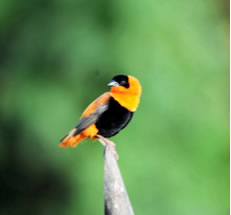 We were soon on the road which seemed a little quieter; perhaps some of the population like a lie-in on a Sunday. We left the vehicle a couple of hundred yards from the entrance which again was guarded by several army guys carrying large rifles: apparently the army has taken control of the area and are allowing birding, something the previous owner would not. A male Northern Red Bishop was in the tall reeds at the side of the road giving great views; it’s a pity my damaged camera lens didn’t do it justice. As we slowly walked towards the entrance some of the birds seen were Long-tailed Starlings, Grey Plantain Eaters, Blue-bellied Roller and Black-necked Weaver. Spur-winged Plovers alarm-called as we approached, encouraging Yellow-billed Shrikes and Red-billed Hornbills to relocate to more distant trees. A pair of Palm Nut Vultures glided by on lazily beating wings, this contrasted sharply with a Zitting Cisticola which performed its far more energetic flight to our right. A Quailfinch was spotted; a bird that had eluded us during our previous visit. Our first African Spoonbills and Red-rumped Swallows were encountered just before the army post where the obligatory passing of a small amount of cash and our obvious deference to the soldiers ensued. Inside the shrimp farm proper we encountered many of the birds associated with this area. Cattle Egret, Hamerkop, Long-tailed and Great Cormorant, Great Egret, Darter and both Grey and Black-headed Herons stood in a tight huddle as though they were discussing the weather. A loose flock of 50-60 White-faced Whistling Ducks took flight having been disturbed by a hunting Marsh Harrier. Lesser Flamingos fed in a distant pan whilst White-backed Pelicans looked on from the raised banks. Smaller waders, Curlew Sandpiper, Little Stint, Ringed Plovers, Redshank, Green and Common Sandpipers populated the pans where the water was shallow enough for their liking and Black-winged Stilts & Avocets accompanied them. Our Breakfast was opened to find a tray of fruit, something we had declined when ordering. It’s not that we don’t like fruit; just not for breakfast.
We were soon on the road which seemed a little quieter; perhaps some of the population like a lie-in on a Sunday. We left the vehicle a couple of hundred yards from the entrance which again was guarded by several army guys carrying large rifles: apparently the army has taken control of the area and are allowing birding, something the previous owner would not. A male Northern Red Bishop was in the tall reeds at the side of the road giving great views; it’s a pity my damaged camera lens didn’t do it justice. As we slowly walked towards the entrance some of the birds seen were Long-tailed Starlings, Grey Plantain Eaters, Blue-bellied Roller and Black-necked Weaver. Spur-winged Plovers alarm-called as we approached, encouraging Yellow-billed Shrikes and Red-billed Hornbills to relocate to more distant trees. A pair of Palm Nut Vultures glided by on lazily beating wings, this contrasted sharply with a Zitting Cisticola which performed its far more energetic flight to our right. A Quailfinch was spotted; a bird that had eluded us during our previous visit. Our first African Spoonbills and Red-rumped Swallows were encountered just before the army post where the obligatory passing of a small amount of cash and our obvious deference to the soldiers ensued. Inside the shrimp farm proper we encountered many of the birds associated with this area. Cattle Egret, Hamerkop, Long-tailed and Great Cormorant, Great Egret, Darter and both Grey and Black-headed Herons stood in a tight huddle as though they were discussing the weather. A loose flock of 50-60 White-faced Whistling Ducks took flight having been disturbed by a hunting Marsh Harrier. Lesser Flamingos fed in a distant pan whilst White-backed Pelicans looked on from the raised banks. Smaller waders, Curlew Sandpiper, Little Stint, Ringed Plovers, Redshank, Green and Common Sandpipers populated the pans where the water was shallow enough for their liking and Black-winged Stilts & Avocets accompanied them. Our Breakfast was opened to find a tray of fruit, something we had declined when ordering. It’s not that we don’t like fruit; just not for breakfast. 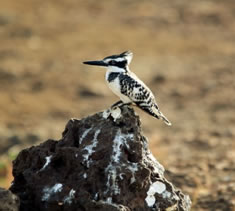 There were also three bread rolls minus the butter, which we were assured would accompany the rolls. So we were left with four rather dry pastries for breakfast, hey ho! At least the birding was good. Gull-billed and White-winged Terns were seen. A Pied Kingfisher obligingly remained on a small rock as we approached so we couldn’t decline the chance of a shot, even with a wonky camera. With the sun high in the sky and temperatures rising, we started the return journey back to the car a couple of kilometres away. Birds were still coming thick and fast; a Grey Kestrel allowed us to approach within camera range; damn my luck! Malick picked up a couple of distant Red-necked Falcons mobbing a hunting Marsh Harrier. A Purple Heron glided by on stiff wings and several Senegal Thick-knees moved across the channel at our approach. Our only Sacred Ibis of the trip flew down the pans towards the river. We reached the car, bade farewell to the military and drove slowly through the village of Pirang to the chants of “Twobarb” from what seemed like the entire village’s children. A quick walk through the Abuko rice fields produced little of note. So we made our way back to the hotel for a desperately needed cup of tea.
There were also three bread rolls minus the butter, which we were assured would accompany the rolls. So we were left with four rather dry pastries for breakfast, hey ho! At least the birding was good. Gull-billed and White-winged Terns were seen. A Pied Kingfisher obligingly remained on a small rock as we approached so we couldn’t decline the chance of a shot, even with a wonky camera. With the sun high in the sky and temperatures rising, we started the return journey back to the car a couple of kilometres away. Birds were still coming thick and fast; a Grey Kestrel allowed us to approach within camera range; damn my luck! Malick picked up a couple of distant Red-necked Falcons mobbing a hunting Marsh Harrier. A Purple Heron glided by on stiff wings and several Senegal Thick-knees moved across the channel at our approach. Our only Sacred Ibis of the trip flew down the pans towards the river. We reached the car, bade farewell to the military and drove slowly through the village of Pirang to the chants of “Twobarb” from what seemed like the entire village’s children. A quick walk through the Abuko rice fields produced little of note. So we made our way back to the hotel for a desperately needed cup of tea.
Day 14 - 14th November
 To-day there was to be no birding except with the scope from our beach front patio. Lesser-crested Terns plunge-dived for fish whilst a steady stream of Gull-billed Terns maintained some interest; although truth be told more birds were unidentified than identified due to the very strong sunlight and the distance of the birds. Most of the day however was spent processing the trip photos and working on the trip report. Several Common Bulbuls joined us for our lunch of small pastries taken from the breakfast table. Our evening meal was taken at the hotel’s Thai Restaurant: both starter and mains were delicious, but a 45 minute wait for the sweet again marred our culinary experience; something that occurred on to many occasions this holiday.
To-day there was to be no birding except with the scope from our beach front patio. Lesser-crested Terns plunge-dived for fish whilst a steady stream of Gull-billed Terns maintained some interest; although truth be told more birds were unidentified than identified due to the very strong sunlight and the distance of the birds. Most of the day however was spent processing the trip photos and working on the trip report. Several Common Bulbuls joined us for our lunch of small pastries taken from the breakfast table. Our evening meal was taken at the hotel’s Thai Restaurant: both starter and mains were delicious, but a 45 minute wait for the sweet again marred our culinary experience; something that occurred on to many occasions this holiday.
Day 15 - 15th November
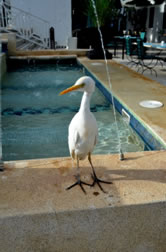 A late breakfast was taken in the company of Colin, a Cattle Egret, who was happy to accept small pieces of bacon which he would dip in the ornamental raised pool adjacent to our table. We were picked up by private transfer for our trip to the airport. A strong tailwind produced an incident free flight and had us back in Birmingham 20 minutes ahead of schedule.
A late breakfast was taken in the company of Colin, a Cattle Egret, who was happy to accept small pieces of bacon which he would dip in the ornamental raised pool adjacent to our table. We were picked up by private transfer for our trip to the airport. A strong tailwind produced an incident free flight and had us back in Birmingham 20 minutes ahead of schedule.
SUMMARY
Species encountered during the trip: Because of the unseasonably high temperatures, time in the field was reduced to little more than 3 hours in the earliest part of day so we consider a trip list of 204 species good value. 28 further species were called but were not seen well enough to confirm.
Accommodation: We will give our honest assessment of the 3 hotels we stayed in.
Ngala Lodge
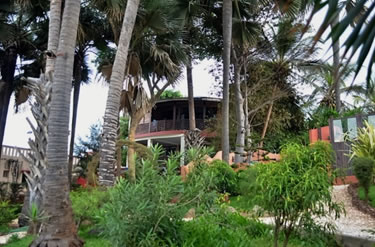 The location of this lodge is probably one of the best in the Gambia. Perched on a raised promontory above a sandy cove with the Atlantic as a backdrop. The grounds are well maintained with large mature Palm trees a feature. Small secluded seating areas are dotted about the grounds. However the hotel is probably 100 feet+ above the beach, so many steps are required to access the beach and sun deck. The beach is public although not really used by the Gambians. Security guards ensure that guests are not pestered. Our room was an Atlantic suite situated on the second floor, giving good elevated views. If we have an issue with this hotel it stems from the catering which, considering it boasts an English head chef we found strange. Birding pre-breakfast meant taking a packed-breakfast. This hotel has no concept of what a packed-breakfast is.
The location of this lodge is probably one of the best in the Gambia. Perched on a raised promontory above a sandy cove with the Atlantic as a backdrop. The grounds are well maintained with large mature Palm trees a feature. Small secluded seating areas are dotted about the grounds. However the hotel is probably 100 feet+ above the beach, so many steps are required to access the beach and sun deck. The beach is public although not really used by the Gambians. Security guards ensure that guests are not pestered. Our room was an Atlantic suite situated on the second floor, giving good elevated views. If we have an issue with this hotel it stems from the catering which, considering it boasts an English head chef we found strange. Birding pre-breakfast meant taking a packed-breakfast. This hotel has no concept of what a packed-breakfast is. 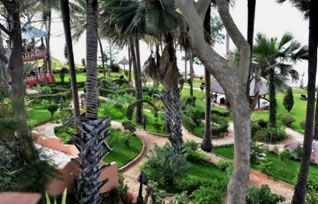 After 5 days of trying to get toast and butter with a boiled egg each, we gave up. In the dining room, whether you had fish, fowl, meat or even a curry, you were served with the same veg every day: a sculpted carrot 2” long, half a roast shallot, a grill-seared slice of aubergine, a cube of beetroot and some mush which we couldn’t identify. Choices of Potato dishes or rice were served separately. Although the waiters wrote down all meals ordered, we never received a meal that was what was ordered; even breakfast, which was just four items, came incorrect. On our last day we had our second cooked breakfast of the holiday and were astonished to find an electric toaster with an adjustable timer!
After 5 days of trying to get toast and butter with a boiled egg each, we gave up. In the dining room, whether you had fish, fowl, meat or even a curry, you were served with the same veg every day: a sculpted carrot 2” long, half a roast shallot, a grill-seared slice of aubergine, a cube of beetroot and some mush which we couldn’t identify. Choices of Potato dishes or rice were served separately. Although the waiters wrote down all meals ordered, we never received a meal that was what was ordered; even breakfast, which was just four items, came incorrect. On our last day we had our second cooked breakfast of the holiday and were astonished to find an electric toaster with an adjustable timer!
Our opinion is this hotel is very much “style over substance”.
Mandina Lodge
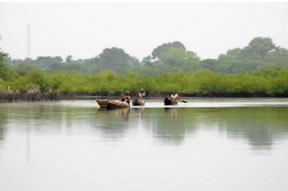 To be fair we were not at Mandina long enough to give a comprehensive critique, but from what we saw and experienced, this is a very impressive Lodge and one we would thoroughly recommend. Situated on a mangrove lined backwater of the River Gambia you really are about as far away from civilisation it’s possible to be in Gambia. Access is down a sandy track that takes 24 minutes to negotiate. No Wi-Fi, air-conditioning, room fridge and only intermittent connection to a mobile network; it’s a place to get away from it all. Other than the odd dug-out canoe carrying a lone fisherman or women who harvest oysters from the mangrove roots, the only people you see are staff and fellow guests. With only 8 lodges there are never more than 20 guests. Our Lodge was the Stilted Lodge, a standalone structure accessed by a 50metre boardwalk.
To be fair we were not at Mandina long enough to give a comprehensive critique, but from what we saw and experienced, this is a very impressive Lodge and one we would thoroughly recommend. Situated on a mangrove lined backwater of the River Gambia you really are about as far away from civilisation it’s possible to be in Gambia. Access is down a sandy track that takes 24 minutes to negotiate. No Wi-Fi, air-conditioning, room fridge and only intermittent connection to a mobile network; it’s a place to get away from it all. Other than the odd dug-out canoe carrying a lone fisherman or women who harvest oysters from the mangrove roots, the only people you see are staff and fellow guests. With only 8 lodges there are never more than 20 guests. Our Lodge was the Stilted Lodge, a standalone structure accessed by a 50metre boardwalk.
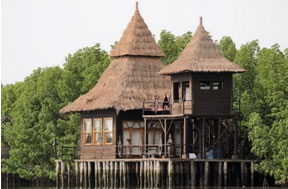 Both our evening meal and breakfast were very tasty, well cooked and plentiful. The staff are genuinely pleased to serve and go out of their way to ensure your stay is a good one. We were supposed to stay at Mandina for seven nights, but due to the extreme heat and humidity it became obvious that due to laboured breathing and tummy troubles our stay would be a short one. Being tucked away in the mangroves meant no cooling breezes to give respite. With all the water around, the humidity was very high necessitating 3 showers and 3 changes of clothing before lunch. As our lodge was constructed of dark-stained timber it retained the heat, meaning that even with the two fans provided running full blast throughout the night and windows open, sleep was almost impossible. Conditions were very, very unseasonable so I would not like to put anyone off from going; it really is a wonderful lodge.
Both our evening meal and breakfast were very tasty, well cooked and plentiful. The staff are genuinely pleased to serve and go out of their way to ensure your stay is a good one. We were supposed to stay at Mandina for seven nights, but due to the extreme heat and humidity it became obvious that due to laboured breathing and tummy troubles our stay would be a short one. Being tucked away in the mangroves meant no cooling breezes to give respite. With all the water around, the humidity was very high necessitating 3 showers and 3 changes of clothing before lunch. As our lodge was constructed of dark-stained timber it retained the heat, meaning that even with the two fans provided running full blast throughout the night and windows open, sleep was almost impossible. Conditions were very, very unseasonable so I would not like to put anyone off from going; it really is a wonderful lodge.
Coco Ocean
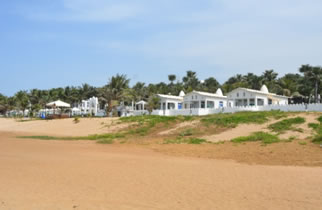 I think this is the only hotel that claims 5 stars in the Gambia. This is a very large complex comprising some 72 suites, 3 restaurants, and a large Spa. Rooms were very spacious with the facilities you would expect in such a hotel. The complex was constructed sympathetically with the environment; several large Palm trees are incorporated into the fabric of the buildings. The Hotel is situated on a very busy main road and fronts onto a large public beach. Security is very tight as the hotel is often used by civic dignitaries and members of parliament. As with the Ngala Lodge, catering was an issue; not one meal was served to us that did not have issues. It is the attention to detail that is lacking, which could make all the difference.
I think this is the only hotel that claims 5 stars in the Gambia. This is a very large complex comprising some 72 suites, 3 restaurants, and a large Spa. Rooms were very spacious with the facilities you would expect in such a hotel. The complex was constructed sympathetically with the environment; several large Palm trees are incorporated into the fabric of the buildings. The Hotel is situated on a very busy main road and fronts onto a large public beach. Security is very tight as the hotel is often used by civic dignitaries and members of parliament. As with the Ngala Lodge, catering was an issue; not one meal was served to us that did not have issues. It is the attention to detail that is lacking, which could make all the difference.
MOANS, GROANS and MEMORABLE MOMENTS
Moan: The fume choked roads are a real issue. The numbers of vehicles on the road have increased exponentially since our last visit over 8 years ago: battered old Lorries and beat-up old Mercedes taxis being the worst offenders.
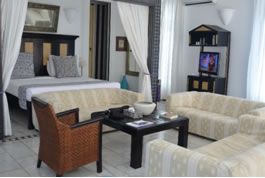 Groan: The incessant background musical beat emanating from a bar adjacent to the Coco Ocean. This noise would continue until about 23.00, although to be fair this did not happen every night, but when it did it was bloody annoying.
Groan: The incessant background musical beat emanating from a bar adjacent to the Coco Ocean. This noise would continue until about 23.00, although to be fair this did not happen every night, but when it did it was bloody annoying.
Moan: Queueing for 1 hour 20 minutes at Thomas Cook check-in at Birmingham airport. Only 3 check-in staff were on duty and 1 of these was dedicated to priority boarding. We were told that the company will not pay for more than 3 check-in staff; they prefer to have their clients queue unnecessarily. We won’t be using Thomas Cook again!
Groan: Birmingham Airport was mentioned as a possible recipient for a second runway and in competition with Manchester as the top airport outside London. With capacity running at only 50% why was our return flight put on a gate that required steps and a bus, especially as it was 10 o’clock at night and raining? Incidentally, sky bridges were free at the time of our arrival.
Memorable Moment: Seeing the 3 White-backed Night Heron chicks on the nest: a very hard bird to see at the best of times, but to see the nest was unbelievable.
Memorable Moment: An African Harrier Hawk ripping out the leaf litter in the crowns of the Palm trees looking for nests whilst being harassed by Crows, Hornbills, and Kites.
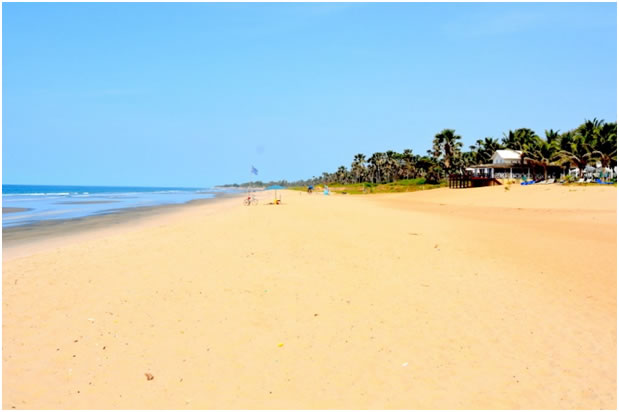
Coco Ocean beach, showing the elevated Tia Restaurant, top right
Species Trip List
Bird Photos 
PDF Copy of Trip Report
Pat & Judy Hayes
